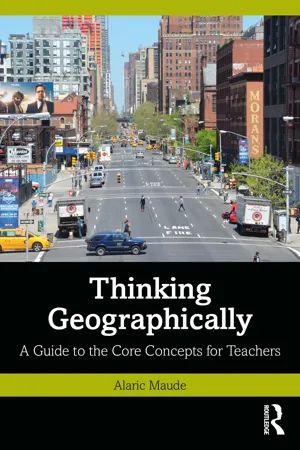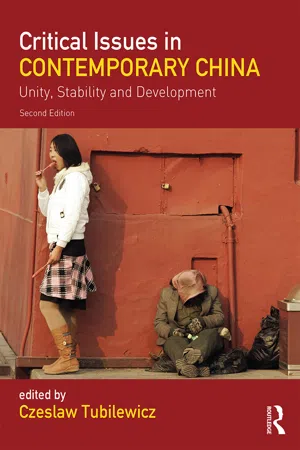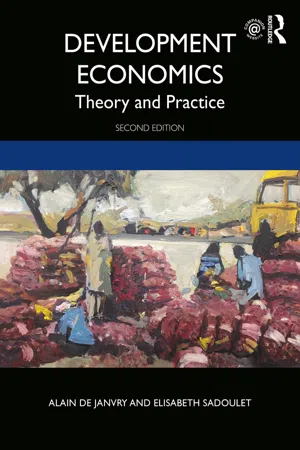Geography
Equity and Inequality
Equity refers to fairness and justice in the distribution of resources and opportunities, while inequality refers to disparities in these distributions. In geography, equity and inequality are studied in relation to access to resources, land use, and socio-economic conditions within and between different regions. Understanding these concepts helps geographers analyze spatial patterns of development and identify areas in need of intervention.
Written by Perlego with AI-assistance
Related key terms
4 Key excerpts on "Equity and Inequality"
- eBook - ePub
Thinking Geographically
A Guide to the Core Concepts for Teachers
- Alaric Maude(Author)
- 2023(Publication Date)
- Routledge(Publisher)
Chapter 11 Unequal places Should governments try to reduce regional inequalities?DOI: 10.4324/9781003376668-12The topic is expressed as a question to be debated; not as content to be learned.In 2014 world leaders ranging from presidents of America and China, the Pope, the Business leaders who meet at Davos and even those who now run the World bank all ranked economic inequality as an issue of importance among the top three in the world.(Dorling, 2015 , p. 24)The quotation identifies economic inequality as a major contemporary issue. It can be studied at an international, national or urban scale; the first of these is a common topic in school geography, often under the title of development geography. At the national scale, inequality can be examined in two ways: one looks at the differences in incomes within a country between richer and poorer groups of people, which is more common, while the other looks at income differences between regions within a country. Both forms of inequality contribute to the issues identified in the quotation, but this chapter takes the second more geographical approach to understanding economic inequality and its consequences by focusing on regional inequality. This is a topic sometimes missing from school curriculums, but it is one that affects the lives of many students in Europe, the USA, Canada, Australia and New Zealand, and is associated with some significant, economic, social, environmental and political issues. To keep it manageable, the discussion is limited to high-income countries.To answer the question, students will first need to understand what economic inequality means and looks like and then examine regional inequality. They then will need to identify the effects of regional economic inequality and decide if these effects justify a policy response. On the principle that young people should never learn about a problem without also learning about how it could be mitigated, the chapter also reviews ways of reducing regional inequalities. - eBook - ePub
Development Economics
Theory and practice
- Alain de Janvry, Elisabeth Sadoulet(Authors)
- 2015(Publication Date)
- Routledge(Publisher)
et al. (2014) show that ethnic diversity, affecting ethnic fractionalization, has been associated with a greater frequency of civil conflict in the last half century. Their interpretation is that genetic diversity undermines trust and cooperation, increases income inequality, and reduces investment in public goods. If many current development outcomes are shown to have their roots in factors that were determined a very long time ago, as far back as the dawn of humanity, then initial conditions continue to matter.What Role for Equity in Development?
The WDR 2006 (World Bank, 2005a) addressed the issue of Equity and Development , an important dimension of development previously neglected. It is not clear, however, that the policy implications of addressing equity bring in much that was not there before in the pursuit of development.Equity is defined as equality of opportunity for success: it is an ex-ante concept relative to outcomes. Equity requires level playing fields so development outcomes for individuals depend only on their levels of effort and on luck, not on particular circumstances such as their individual characteristics, asset endowments, and the contexts in which the assets they have are used. The WDR 2006 documents the fact that there are massive inequities attached to gender, race, caste, place of birth, parental education, paternal occupation, and parental socio-economic status.According to Roemer (2012), the traditional utilitarian “equality approach” to development consists in equalizing outcomes such as income, wages, and life expectancy. By contrast, an “equal opportunity approach” to development equalizes outcomes only at equal levels of effort. It requires equalizing the role of circumstances on outcomes at given effort. Alternatively, it requires eliminating inequalities that are due to circumstances for which persons should not be held responsible as they are beyond their control. - eBook - ePub
Critical Issues in Contemporary China
Unity, Stability and Development
- Czeslaw Tubilewicz(Author)
- 2016(Publication Date)
- Routledge(Publisher)
11 Inequality of opportunitiesKong Tao, Jane Golley and Dong LuSocio-economic inequality is a challenge that has received global attention for decades, with the main concern being the widening gap between the rich and the poor. Recent American survey data reveal that many think that, while education and working hard are important for getting ahead, knowing the right people and belonging to a wealthy family are also critical (Pew Research Center 2014). This finding underlines the fact that inequality is commonly perceived as an outcome that arises from a combination of individuals’ talents and efforts, and their circumstances. Indeed, Rawls (1999) argues that the distribution of opportunities and that of outcomes are equally important and informative for understanding the nature and extent of inequality around the world. As two distinct but interrelated concepts, inequality of outcomes refers to the disparity among households and individuals in terms of realized results of certain variables, such as income, wealth, education and health; inequality of opportunity occurs when individuals do not have the same chances to pursue their life goals due to predetermined circumstances beyond their control, such as gender, race, place of birth, family situation (Roemer 1993, 1998). Disparity in outcome, be it income, wealth or education, if driven by variation in abilities is generally deemed acceptable, while inequality caused by uneven opportunities is thought to be unjustified and requiring to be addressed. Precisely because of this consideration, this chapter focuses on the role of inequality of opportunities in China.Over the course of the last nearly four decades, China has achieved remarkable economic growth. Its GDP grew by nearly 10 per cent per annum, and household income in urban and rural areas by 8 per cent, between 1978 and 2012. By 2014 the GDP per capita of China, measured in current US dollars, reached about US$7,500, making it one of the upper middle-income countries.1 While the GDP and household income growth have been exceptional, China has witnessed a drastic transformation from an egalitarian society more than 30 years ago to one that has experienced a sharp increase in income inequality since the beginning of the 1980s. With its official Gini coefficient approaching 0.5 (0.474 for 2012), China’s level of income inequality is comparable with that of relatively high-inequality countries such as Brazil (0.529), Chile (0.505) and Colombia (0.535) as of 2013 (World Bank).2 - eBook - ePub
Development Economics
Theory and Practice
- Alain de Janvry, Elisabeth Sadoulet(Authors)
- 2021(Publication Date)
- Routledge(Publisher)
2005b ) addressed the issue of equity and development, an important dimension of development, previously neglected. It is not clear, however, that the policy implications of addressing equity bring in much that was not there before in the pursuit of development.Equity is defined as equality of opportunity for success: it is an ex ante concept relative to outcomes. Equity requires level playing fields so development outcomes for individuals depend only on their levels of effort and on luck, not on particular circumstances such as their initial individual characteristics, asset endowment, and context. The World Development Report 2006 documents the fact that there are massive inequities attached to gender, race, caste, place of birth, parental education, paternal occupation, and parental socioeconomic status.According to Roemer (2013 ), the traditional utilitarian “equality approach” to development consists of equalizing outcomes such as income, wages, and life expectancy. By contrast, an “equal opportunity approach” to development equalizes outcomes only at equal levels of effort. It requires equalizing the role of circumstances on outcomes at given effort. Alternatively, it requires eliminating inequalities that are due to circumstances for which persons should not be held responsible as they are beyond their control.But why should policy be concerned with equity in development? There are two reasons: one intrinsic, the other instrumental.The intrinsic value of equity is the broadly shared feeling that egregious disparities of opportunity violate a sense of fairness, particularly when the individuals affected can do little about them. For Rawls (1971 ), this can derive from a self-serving concern that if we do not know where we will fit in the distribution of opportunities, due to what he called the “veil of ignorance,” we should a priori prefer a more egalitarian distribution of opportunities. Political philosophies, international human rights declarations, and leading religions are all concerned with equity—and achieving a certain level of equity should be an important dimension of wellbeing, that is, of development, as defined in Chapter 1 . This has been the objective of affirmative-action policies: redressing inequities by equalizing chances of success, generally by creating the positive advantages necessary to compensate for unequal initial circumstances (Roemer, 1998
Index pages curate the most relevant extracts from our library of academic textbooks. They’ve been created using an in-house natural language model (NLM), each adding context and meaning to key research topics.



